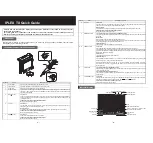
S-AD-M-005
Chapter 1: System Overview
January 2006—Page 1 of 35
To permit four passes through the main amplifier, the polarization of the beam must be rotated
to prevent the beam from being reflected out of the cavity following the second pass. The PEPC is used
to accomplish this. It is an electro-optic device developed at LLNL that rotates the electric-field vector
of plane-polarized radiation by 90º. For four-pass operation, the PEPC is initially in its “off” state. After
the pulse has passed through the PEPC, the device is switched to its “on” state by applying a high voltage
(~20 kV). The returning beam is then rotated to a vertical polarization state, making it
p
-polarized relative
to the Brewster’s angle polarizer POL1, resulting in high transmission through the polarizer. The beam
then reflects from the cavity end mirror and returns through the polarizer and the “on” PEPC. The PEPC
rotates the beam’s polarization another 90º back to its initial, horizontal orientation. The voltage on the
PEPC is then turned off, and, following the fourth pass, the beam is switched out of the cavity by POL1
and returns to the upper beamline.
The net small-signal gain through the main and booster amplifiers is ~10
5
. The deformable mirror
at one end of the laser cavity corrects for low-spatial frequency aberrations (of length scale ≥33 mm)
introduced by the amplifier disks. A sample of the output beam immediately after the TSF is deflected
to a Shack–Hartmann wavefront sensor. The output of the wavefront sensor is used to generate error-
correction signals sent to each of 39 actuators on the deformable mirror.
The cavity and transport spatial filters each use a pair of aspheric lenses housed at the ends of
evacuated tube assemblies to spatially filter the light between amplifier passes and to provide relay-plane
imaging. The cavity spatial filter relays the image plane of the front-end apodizer to the deformable
mirror. North of the TSF assembly there is a diagnostic beamsplitter mirror (DBS) to provide a path to
beam diagnostics and alignment packages.
In both the cavity and transport spatial filters, the beam passes through a different pinhole on each
pass through the spatial-filter focal plane. This “angular multiplexing” reduces the likelihood of pinhole
closure in the cavity spatial filter, where there are four pinholes in an assembly, one for each pass. Angular
multiplexing is used in the TSF to allow the seed beam to be injected into the main beamline.
To permit two passes through the main amplifier, the polarization of the beam does not need
to be rotated to prevent the beam from being reflected out of the cavity following the second pass. The
PEPC remains in its passive state while the pulse is in the cavity so that the pulse exits the cavity after
its second pass. A second Brewster’s angle polarizer (POL2) is inserted in the cavity during short-pulse
operation, oriented 90º in azimuth from POL1, so that light will be transmitted when the PEPC is “off.”
In conjunction with the PEPC, POL2 provides a simple means of preventing back-reflected pulses from
the target from re-entering the main amplifier. (Pulses back-reflected from the target could extract gain
from the amplifiers and damage the injection mirror in the TSF.) The PEPC is pulsed “on” just after
the main pulse exits the cavity. Back-reflected light that has re-entered the beamline has its polarization
rotated by the PEPC and is rejected from the system by POL2 into a beam dump before it can reach the
main amplifier disks and deformable mirror.
This second polarizer is only used when the beam is operated in short-pulse mode (two or four
pass), when there is a risk of IR light being back-reflected from the target. In long-pulse mode, any UV
light reflected from the target cannot pass the IR transport mirror and cannot re-enter the beamline.
POL2
3
is removed from the cavity to avoid damage in this mode of operation. Insertion of POL2 into the
cavity introduces a shift in the beam centerline that is compensated for by the insertion of an oppositely
3
Note: Only the short-pulse Beamlines 1 and 2 have the second polarizer (POL2).
Summary of Contents for Volume VII-System Description
Page 38: ......
















































